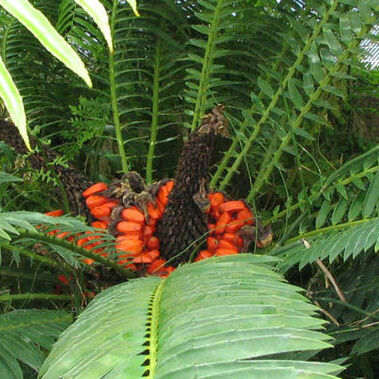Palm-like plants with subterranean to tall and erect, usually unbranched, cylindrical stems. Stems clad with persistent leaf bases (in Australian genera). Leaves simply pinnate, spirally arranged, seasonally interspersed with cataphylls; pinnae sometimes dichotomously divided. Longitudinal ptyxis erect to inflexed or sometimes reflexed; horizontal ptyxis conduplicate. Pinnae with several subparallel, dichotomously branching, longitudinal veins, lacking a midrib; stomata on both surfaces or undersurface only; individual ptyxis flat. Trichomes coloured or transparent, branched or unbranched, short-curved or irregular. Male and female sporophylls spirally aggregated into determinate axillary cones. Female sporophylls simple, appearing peltate, with a barren stipe and an expanded and thickened lamina with 2 (rarely 3 or more) sessile, orthotropous ovules inserted on the inner (axis-facing) surface and directed inwards ('inverted'). Seeds radiospermic.
Fern-like plants with a naked, subterranean stem producing 1-many short, slender, determinate leaf-and cone-bearing branches, sometimes themselves branched. Cataphylls absent. Leaves pinnate or bipinnate. Pinnules with or without a distinct midrib. Trichomes coloured or transparent, unbranched, shortly curved. Male and female sporophylls peltate, without terminal spines, spirally orthostichous and aggregated into terminal cones. Male sporophylls with 2 collateral fertile areas on the abaxial surface, and numerous sporangia. Female sporophylls with 2 sessile inverted ovules on the inner surface. Seeds radiospermic.

